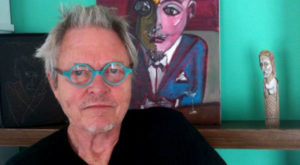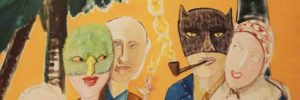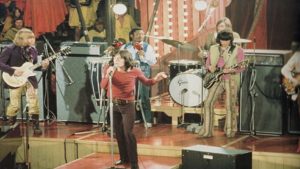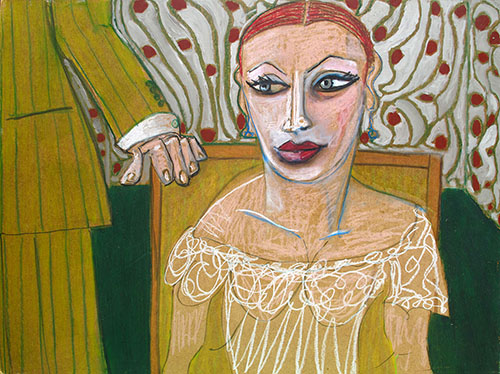I have to preface this sketch with an admission that seems odd even to me – as someone fairly impervious to the lure of Hollywood legend. What drew me to the first show I ever saw of Michael Lindsay-Hogg’s fine art was that he was a Hollywood legend. But that term goes with an asterisk, exclamation point, and a dagger straight through the heart. The Hollywood-Brit nexus is part of it, and Lindsay-Hogg was steeped in those connections from infancy. Then there’s the Orson Welles–Geraldine Fitzgerald business we all know about. But what really vaulted him into that empyrean league for me (and possibly a sibling or two) was his role as the director of The Rolling Stones Rock and Roll Circus in 1968. This led us to our discovery of some of his other film and video work for both the Stones and the Beatles. Then there was the documentary film of the Beatles’ Let It Be with that amazing studio roof-top concert. And there was more: Nasty Habits was an all-women satire of the Watergate scandal that transposed the West Wing to a convent with Glenda Jackson and an all-star chain-smoking cast. From there he moved on to the television serialized Brideshead Revisited. Then there was Broadway (Agnes of God). And Off-Broadway – Larry Kramer’s The Normal Heart – and much, much more since and in between.
 My first glimpse of Michael Lindsay-Hogg’s work as a fine artist (and it was only a glimpse – on-line and probably close to seven years ago) could be summed up as ‘inconclusive’. One image can only tell you so much. But if anyone could make something of a simple tableau of anywhere from one to a half-dozen figures without a script, it’s Lindsay-Hogg. His gift for sharply etched characterization was on abundant display in the first paintings I saw; but also, more remarkable still for their simplicity, an atmospheric quality. With his latest series of paintings and drawings, Lindsay-Hogg appears to be veering from the sort of Max Beckmann late Expressionist ‘New Objective’ style he began with to something verging on caricature; but the tension holds steady. Something has just happened or is about to happen amongst these figures who look uncannily like people we know, or people we know something about but have never met, or people we’ve met many times but will never really know. There’s something theatrical about them – posed, costumed just so (even in attire that can scarcely be identified); and that sort of makes sense, given Lindsay-Hogg’s life and experience. But they’re entirely imaginary – imaginary figures that, by Lindsay-Hogg’s telling, seem to compose themselves by free-association. We chatted briefly by phone earlier this week about his process, and its overlap and continuity with his work in film, theatre, and rock ‘n’ roll.
My first glimpse of Michael Lindsay-Hogg’s work as a fine artist (and it was only a glimpse – on-line and probably close to seven years ago) could be summed up as ‘inconclusive’. One image can only tell you so much. But if anyone could make something of a simple tableau of anywhere from one to a half-dozen figures without a script, it’s Lindsay-Hogg. His gift for sharply etched characterization was on abundant display in the first paintings I saw; but also, more remarkable still for their simplicity, an atmospheric quality. With his latest series of paintings and drawings, Lindsay-Hogg appears to be veering from the sort of Max Beckmann late Expressionist ‘New Objective’ style he began with to something verging on caricature; but the tension holds steady. Something has just happened or is about to happen amongst these figures who look uncannily like people we know, or people we know something about but have never met, or people we’ve met many times but will never really know. There’s something theatrical about them – posed, costumed just so (even in attire that can scarcely be identified); and that sort of makes sense, given Lindsay-Hogg’s life and experience. But they’re entirely imaginary – imaginary figures that, by Lindsay-Hogg’s telling, seem to compose themselves by free-association. We chatted briefly by phone earlier this week about his process, and its overlap and continuity with his work in film, theatre, and rock ‘n’ roll. 
“Sometimes I just draw or paint a line; and then the line will continue and become a face. And the face may be on the left side of the canvas; and then I’ll draw another bit of a body or a face on the other side, the nose and mouth and character markings. The personalities can be benign or caustic or dissatisfied with each other … and when I put clothes on them, they become characters that have some connection to each other.”
Lindsay-Hogg doesn’t try to dictate the situation, the backdrop or premise – though he knows when to make a decisive intervention.
“I like what they tell me … whether they’re going to look male or female, what they make as a group together, or solo, which is a kind of accidental creation – nose or eyes turned up or down, or hairstyle. A figure will start based on what I’ve seen; then a woman may turn into a man, or a man into a woman. If I didn’t get exactly what I thought it would be, then I work with what it is – which is sometimes the way I work as a director.”
This goes all the way back to his earliest experiences as a director – specifically rock films and video. “In rock ’n roll, things change in an instant. You have three musicians, and then one wanders off. I work with what’s right in front of me in the moment.”
Thinking back to the Beatles’ Let It Be, it occurred to me that he was probably dealing with this kind of situation through the entire production of the film. But this was also a situation he encountered in the theatre.
“You take what’s in front of you, rather than the script … say, three characters, two chairs, and a stand-up ashtray. You couldn’t have them all standing all in one way, one place…. Maybe they need to be five feet away from one another because it looks better. If you have two characters, the audience can compose a two-shot; but if you have more, you move them further away, so the audience cuts to the character. You learn something about composition working this way.”
Looking at some of these paintings and drawings, the situations poised uncertainly between the banal and the sinister, makes me wonder if he’s simply imagining a set of characters to be written into a script or a fantasy cast to direct. “I get interested in the dynamic between people.” At one point, he mentions some pictures he did based upon a news photo of Brooke Astor’s son being led from a courtroom by a female police officer to (presumably) jail – he has a sizeable collection of newspaper clips and postcards he can draw upon on the rare occasion he feels “needy of inspiration.”
“I think one of the reasons I like painting and drawing – and I draw all the time – is that unlike theatre and movies, it’s an autonomous thing that can’t be manipulated. It’s a more hermetic art because it’s just you doing it. If you want the sky green, the composition a certain way, if it makes sense to you, there’s no one to recut it. There’s some kind of narrative between the people in the pictures, but what interests me more here are the marks on the surface….
“Occasionally I get more involved with them as works in progress until they seem to be finished; but then I’ll take them off the easel and I look at them as different animals. Some become favorites; some I’m going to miss more than others.”


